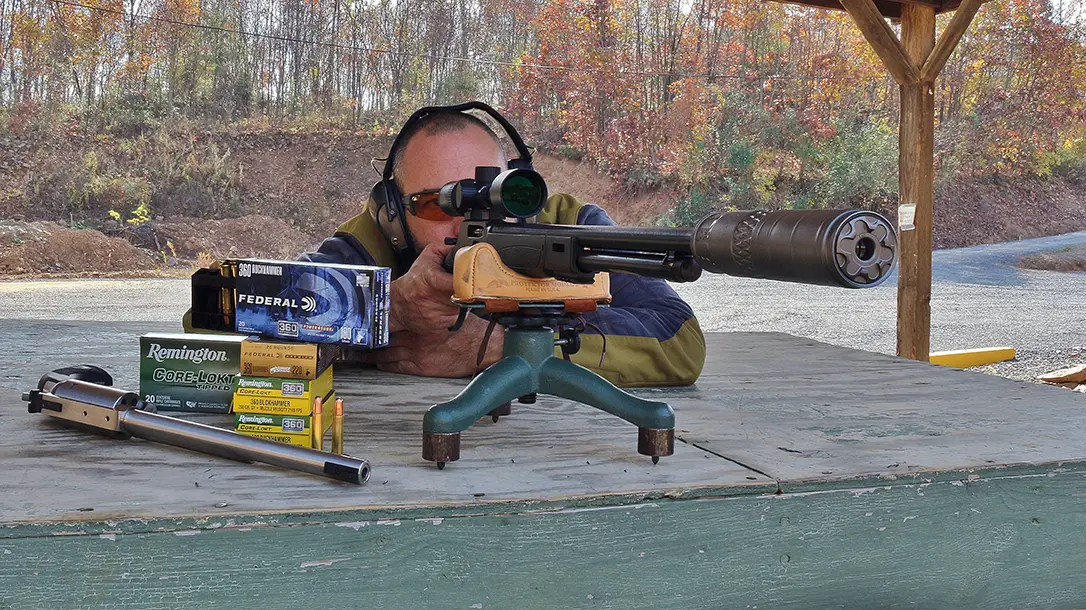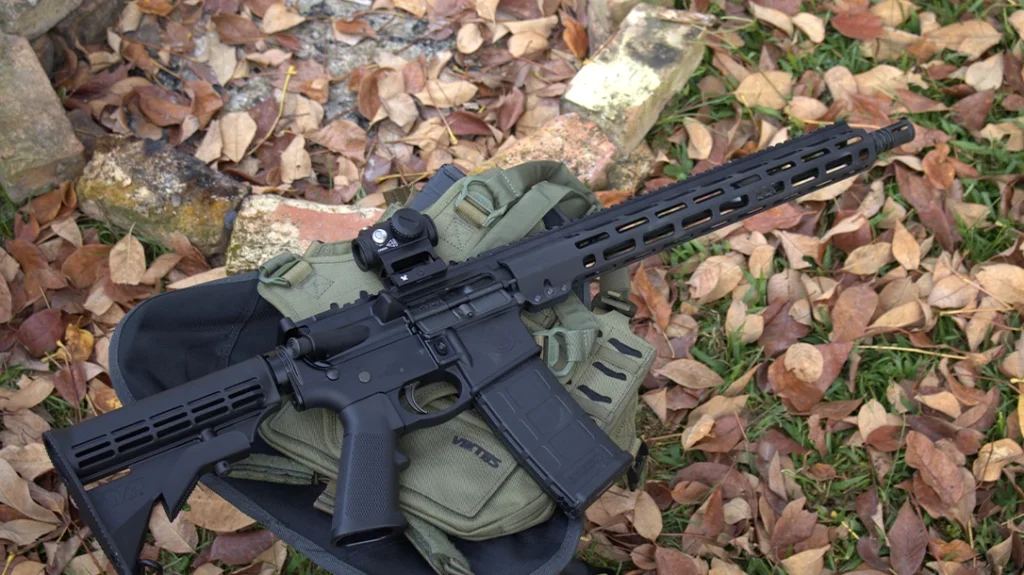A straight-walled phenomenon is sweeping across the land, opening doors to hunters previously limited to shotguns and muzzleloaders during the regular firearms season. Many jurisdictions formally restricted these sportsmen and women to the latter firearms. Officials believed their limited range would help contain errant projectiles to the woods. Shotguns and muzzleloaders bring excessive recoil or a rigorous cleaning procedure after firing just a solemn shot. With a little convincing, some politicians were able to identify non-bottlenecked cartridges as having a similar range and, thus, the same level of containment when fired in the wild. New .360 Buckhammer ammunition continues taking advantage of this trend.
.360 Buckhammer Ammunition Loads
With that, cartridges like the 350 Legend took center stage. Although formidable, it left shooters wanting more, particularly those who enjoy hunting with a lever action. This would change in 2023 when Remington announced the .360 Buckhammer – a rimmed .35-caliber cartridge capable of creating an enormous amount of energy. Team Green piloted the cartridge with a 180- and 200-grain Core-Lokt load, which has proven to be good medicine for whitetail deer. As more firearms hit the scene, Remington branched out a bit and its sister company, Federal, also joined the party. There are five loads available as of this writing, and I was able to gather a sample of each for a thorough analysis.
As previously mentioned, several manufacturers chamber firearms for the .360 BHMR, so for this test, I recruited two of the latest. Henry Repeating Arms expanded its polymer-clad X line with a 21.375-inch barreled specimen, complete with 5/8x 24 threading. As the .360 suppresses nicely, I screwed a Rugged Alaskan360Ti can to the end for quieter testing. This suppressor, made entirely from Grade 5 Titanium, weighs a paltry 5.6 ounces. Hanging it off of the end of a rifle is barely noticeable, except for when it comes time to pull the trigger. Cut with a faster 1:12 twist, the Henry X ought to have little trouble stabilizing heavier pills when factory subsonic loadings eventually come into play, making this a superbly quiet game-getter when topped with this can.
Advertisement — Continue Reading Below
Biggest FINEST Buckhammer

You might be surprised to read that there is indeed a revolver chambered to fire the .360 Buckhammer, and I am not too modest to suggest that I had some influence on its design. Based on the .30-30 Winchester, any company with an existing firearm chambering already possesses the tools to create a Buckhammer. Introducing key employees at Remington to the folks at Magnum Research, the revolver needed only minor changes to create a BFR (which, of course, stands for Biggest FINEST Revolver) that could handle this round. Weighing in at an even 5 pounds and wearing a 10-inch barrel, its sheer mass helps tame recoil and is an excellent choice for hunting that involves a long hike but only a short shot.
I began testing with the very first load I’ve ever fired, the Remington 180-grain Core-Lokt. A musket ball of a projectile, you can only expect a ballistic coefficient of .163, but since this is intended for short-range hunting, that shouldn’t be too concerning. This bullet has been around for generations and features an exposed lead core that is mechanically bonded to a tapered copper jacket. This composition quickly initiates expansion, while the taper limits and controls it through its passage. Although I’ve used the round before, I’ve yet to fire it through a suppressor, let alone a handgun. As this hails from the lightest class of bullet currently loaded, it produced the fastest velocities in both firearms. Recoil was incredibly manageable despite the 2,149 ft./lbs. of energy, generated from the rifle and 1,663 ft./lbs. it created from the pistol.
Advertisement — Continue Reading Below
Bigger Bullets
Moving to the heavier version of this round, I loaded up the 200-grain Remington Core-Lokt ammunition. This projectile will tug at the heartstrings of those who grew up hunting with .35 Remington, as it’s the very same pill that helped that cartridge achieve its fanbase. Built with the same construction as its lighter brother, this is simply a heavier, longer version of that projectile. The extra 20 grains bump the ballistic coefficient up to .184, which isn’t a particularly noticeable amount, but nonetheless, it helps it carry its velocity a touch better.
Contrary to what you’d expect, these were quite mild to fire, and I couldn’t accurately judge if they had more or less kick than their 180-grain counterparts. My rifle was able to pull 2,091 ft./lbs. of muzzle energy from this load while the pistol-length barrel dropped it down to 1,528 ft./lbs. Either is going to do the trick for medium or even big game. At the end of the day, it also proved to be the Henry X’s preferred accuracy load.

Advertisement — Continue Reading Below
Shok & Awe
Nearly as iconic as the Core-Lokt line is Federal’s Power Shok family. This low-cost ammunition offers a traditional soft-point bullet that is ideal for informal hunting and target shooting. Also, 180 grains in weight it will produce similar velocities and trajectories as Reminton’s Core-Lokt load of the same weight. Pistol testing revealed a muzzle energy of 1,559 ft./lbs., while we calculated 2142 ft./lbs. from our rifle. A ballistic coefficient of .173 puts it somewhere between Remington’s two soft-point offerings, while accuracy results were acceptable in the Henry X and just plain excellent in the BFR.
Introduced in 2020, Federal’s Hammer Down line is built specifically for lever-action rifles. This product line was created in synchrony with Henry Repeating arms, so I was expecting a Buckhammer load from the start. Cases from the Hammer Down line feature a beveled rim, which helps them slip though loading gates without hanging up. It also helps with reinstalling inner magazine tubes, as these rims no longer offer a flat wall for them to stop against. The bullet is equally impressive as its conical profile creates a ballistic coefficient of .263 and features a molecularly bonded jacket. With a muzzle energy of 1806 ft./lbs. from the rifle, these were actually some of the softest shooting loads fired that day.
Although slower, the higher BC helps the projectile to cover more ground during its flight, thus only dropping about as much as the lighter 200-grain Remington load. Surprisingly, it only lost about 20% of its energy when fired from the pistol, producing 1427 ft./lbs. Also surprising was the accuracy it produced for a firearm it clearly wasn’t created for.
Advertisement — Continue Reading Below
Core-Lokt Tipped Lever Gun
The last load that I tested was also the newest. Dubbed Core-Lokt Tipped Lever Gun, this round builds off the proven Core-Lokt bullet technology and adds a polymer tip to initiate expansion. The skived 180-grain projectile is more streamlined than its classic counterpart, thus creating the same BC as Federal’s modernized bullet, which is 40 grains heavier. It produced 1637 ft./lbs. of slap from the BFR, making it the second hardest-hitting round fired from the handgun. A calculated 2,231 ft./lbs. of muzzle energy from the Henry X puts it at the top for rifle work. Despite these numbers, I still found recoil manageable, and the higher energy levels ought not to scare off a timid shooter.
Taking the entire lineup of .360 Buckhammer ammunition to the range was an eye-opening experience. Every cartridge produced more than adequate accuracy results for hunting applications, with each firearm having a distinct favorite. Power factors across the board would be devastating on deer-sized game with some of the firearm/ammo combinations showing enough promise to harvest elk even. Above all, I’m happy to see this cartridge is on the uptick, and the growing number of options means that more hunters and shooters are going to be able to find the perfect load for their firearm and individual needs.

Advertisement — Continue Reading Below



Advertisement — Continue Reading Below
Shooting Results – Henry X (100 yards)
| Load | Velocity (10 feet) | Smallest Group (inches) | Average Group (inches) |
| Federal Hammer Down 220-grain Bonded SP | 1,923, 16 Sd | 2.47 | 2.89 |
| Federal Power Shok 180-grain JSP | 2,315, 19 Sd | 2.14 | 2.51 |
| Remington Core-Lokt 180-grain SP | 2,319, 22 Sd | 1.30 | 1.61 |
| Remington Core-Lokt 200-grain SP | 2.171, 24 Sd | 1.06 | 1.25 |
| Remington Core-Lokt Tipped Lever Gun 180-grain Core-Lokt Tipped | 2.363, 13 Sd | 2.35 | 2.81 |
Shooting Results – Magnum Research BFR (25 yards)
| Load | Velocity (10 feet) | Smallest Group (inches) | Average Group (inches) |
| Federal Hammer Down 220-grain Bonded SP | 1,709, 11 Sd | 1.53 | 1,.78 |
| Federal Power Shok 180-grain JSP | 1,975, 27 Sd | 1.75 | 2.02 |
| Remington Core-Lokt 180-grain Core-Lokt SP | 2.040, 19 Sd | 2.62 | 2.99 |
| Remington Core-Lokt 200-grain Core-Lokt SP | 1,867, 35 Sd | 2.68 | 3.12 |
| Remington Core-Lokt Tipped Lever Gun 180-grain Core-Lokt Tipped | 2,024, 20 Sd | 2.47 | 3.01 |
Wildlife Research Center Scent Killer Gold Product Line

Advertisement — Continue Reading Below
Having a winning gun and ammo combo is essential but wholly useless unless something comes within range. Wildlife Research Center’s Scent Killer product line offers treatments for laundry as well as your body to help keep human scents at home. The field spray provides a final touch to mask odors that you might pick up in your vehicle and continues to work for several days, even after it’s dry. These items are available individually or in a handy kit at wildlife.com.
























